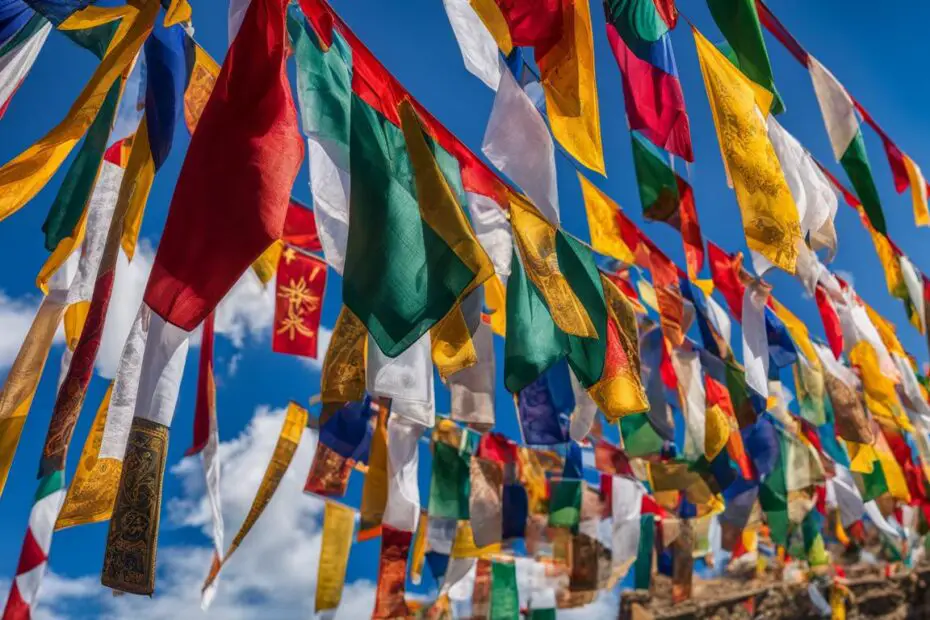Tibetan prayer flags have a deep-rooted cultural significance and serve as powerful symbols of spirituality. These rectangular fabric banners, found along paths and peaks in Tibet, Nepal, Bhutan, and the Himalayas, are adorned with prayers, mantras, and symbolic imagery. The vibrant colors and intricate designs hold profound meanings, promoting peace, harmony, and enlightenment.
At the heart of prayer flags lies their relationship with the wind. It is believed that as the wind blows, it carries the blessings and positive energy contained within the flags, spreading them to all beings. This connection with the elements and the natural world is an integral part of their symbolism.
Key Takeaways:
- Traditional prayer flags are colorful rectangular fabric banners with symbolic prayers and mantras.
- They are hung along paths and peaks in Tibet, Nepal, Bhutan, and the Himalayas.
- The significance of prayer flags lies in their association with the wind, symbolizing blessings for all beings.
- Prayer flags promote peace, harmony, and spiritual awakening.
- Their vibrant colors and intricate designs hold deep cultural and spiritual meanings.
The History and Meaning of Tibetan Prayer Flags
Tibetan prayer flags have a rich history dating back to ancient times. These flags were initially created by the Tibetan king Gesar of Ling as symbols of victory over evil forces and to promote peace within his kingdom. Over the years, the tradition of hanging prayer flags spread throughout Tibet and became an integral part of Tibetan Buddhism. Each flag represents a different aspect of Buddhist teachings, making them meaningful symbols of spiritual significance.
These flags are not just visually stunning; they also carry deep symbolic meaning. The colors used on the flags hold special significance, with blue representing the sky, white representing air, red representing fire, green representing water, and yellow representing earth. The arrangement of the colors and the placement of the flags also have specific meanings. For example, when the flags are hung vertically, they represent the five elements coming together in harmony.
One of the most frequently seen types of Tibetan prayer flags is the Lung Ta, also known as the “wind horse” flag. The wind horse is a powerful symbol in Tibetan culture, representing energy and movement. The Lung Ta flag symbolizes strength, vitality, and the upward flow of spiritual energy. When the wind blows, it is believed to carry the blessings and prayers printed on the flags to all beings, spreading peace, compassion, and wisdom.
The Symbolism of Buddhist Prayer Flags
The symbolism of Tibetan prayer flags goes beyond their colors and arrangement. Each flag is imprinted with prayers, mantras, and sacred symbols, all with the intention of promoting positive energy and spiritual awakening. The prayers and mantras printed on the flags are believed to be carried by the wind, spreading blessings and well-being to all who are touched by their presence. These prayers can range from simple phrases, such as “Om Mani Padme Hum,” to longer prayers invoking the blessings of specific deities.
Additionally, the symbols printed on the flags have their own meanings. The most common symbols found on Tibetan prayer flags include the Eight Auspicious Symbols of Buddhism, such as the Lotus, the Golden Fish, and the Wheel of Dharma. Each symbol represents a different aspect of Buddhist teachings and holds its own spiritual significance.
| Buddhist Prayer Flags Symbolism | Description |
|---|---|
| Lotus | Represents purity and spiritual enlightenment. |
| Golden Fish | Symbolizes good fortune, abundance, and liberation. |
| Wheel of Dharma | Represents the teachings of Buddha, the path to enlightenment. |
| Endless Knot | Symbolizes the interconnectedness of all things and the eternal nature of the universe. |
| Victory Banner | Signifies the victory of wisdom over ignorance and the triumph of enlightenment. |
| Treasure Vase | Represents spiritual abundance and the fulfillment of all wishes. |
| Parasol | Symbolizes protection from negative influences and spiritual guidance. |
| Conch Shell | Represents the beautiful sound of the Dharma and the call to awaken. |
By understanding the history and symbolism of Tibetan prayer flags, we gain insight into the rich culture and spiritual traditions of Tibet. These flags not only add aesthetic beauty to our surroundings but also serve as powerful reminders of the values and teachings of Buddhism. Whether hung in a religious or decorative context, Tibetan prayer flags continue to inspire and uplift people around the world.
How to Hang and Use Prayer Flags
Tibetan prayer flags are not only beautiful decorative items but also carry spiritual significance. Understanding how to hang and use prayer flags properly can enhance their positive energy and bring various benefits to your space. Here are some guidelines to help you make the most of your prayer flags:
1. Choose the Right Location
When selecting a location to hang your prayer flags, consider outdoor areas with open space and good airflow. This allows the flags to catch the wind and spread their blessings effectively. Prayer flags are commonly hung along paths, rooftops, trees, or sacred sites, but you can also display them indoors near windows or in meditation spaces.
2. Arranging the Flags
Prayer flags are typically hung in horizontal or vertical lines. If you hang them horizontally, ensure that the colors appear from left to right in the order of blue, white, red, green, and yellow. Alternatively, if you hang them vertically, make sure the colors go from top to bottom in the same sequence. This arrangement signifies the elements and promotes balance and harmony.
Pro Tip: Before hanging your prayer flags, take a moment to set a positive intention and offer prayers or mantras for the well-being of all beings.
3. Respect and Care
Handle your prayer flags with care and respect, as they are considered sacred objects. Avoid stepping on them or letting them touch the ground. Over time, weather conditions may cause the fabric to fade or become tattered. Instead of discarding them, consider respectfully burning or burying the old flags, as this is believed to release their blessings into the universe.
Hanging and using prayer flags is a personal and meaningful practice that can bring joy, positivity, and spiritual connection to your life. Embrace the beauty and symbolism of these traditional Tibetan treasures and let their presence fill your space with peace and harmony.

The Cultural and Spiritual Significance of Tibetan Prayer Flags
Tibetan prayer flags carry deep cultural and spiritual significance, serving not only as religious symbols but also as decorative art. These vibrant rectangular fabric banners can be found adorning homes, gardens, and other spaces, bringing a touch of Tibetan culture and positive energy. The tradition of hanging prayer flags has been preserved for centuries, and they continue to inspire and uplift people around the world.
What makes Tibetan prayer flags truly special is their association with the wind. It is believed that when the wind blows, the prayers, mantras, and symbols printed on the flags are released into the world, carrying blessings to all beings. This unique connection between the flags and the wind emphasizes the power of nature and the interconnectedness of all living beings.
The craftsmanship and beauty of Tibetan prayer flags are also worth noting. These flags are hand-printed using traditional woodblock printing techniques and natural pigments. The colors used on the flags hold symbolic meanings, with each color representing a different element. Blue represents the sky, white represents air, red represents fire, green represents water, and yellow represents earth. The combination of these colors creates a visually captivating display that adds to the overall aesthetic appeal of the flags.
| Symbolism | Meaning |
|---|---|
| Blue | The color of the sky, symbolizing universal compassion and wisdom |
| White | Represents air and purity, reflecting clarity and spiritual development |
| Red | Symbolizes fire and power, representing the blessings of the Dharma |
| Green | Represents water and healing, promoting balance and harmony |
| Yellow | Symbolizes earth and generosity, inspiring abundance and prosperity |
In recent years, Tibetan prayer flags have gained popularity in Western cultures as symbols of peace and harmony. They serve as potent reminders of the values and teachings of Buddhism, promoting peace, compassion, and wisdom. Whether used in a religious or decorative context, these prayer flags radiate a sense of harmony and positivity, inviting individuals to connect with their inner selves and the world around them.
“When the wind blows, the prayers and blessings of the Tibetan prayer flags are carried to all beings, spreading positive energy and peace.” – Tibetan proverb
Conclusion
Tibetan prayer flags are not just colorful pieces of fabric; they are symbols of peace, compassion, and wisdom. These flags have a long history and deep meaning in Tibetan culture and Buddhism. Whether used for religious purposes or as decorative art, Tibetan prayer flags serve as reminders of the values and teachings that promote harmony and positivity.
The symbolism of Tibetan prayer flags lies in their vibrant colors, sacred symbols, and prayers printed on them. Each flag represents different aspects of Buddhist teachings, and the colors used hold significance. Hanging prayer flags with positive intentions and treating them with respect is essential to fully harness their benefits.
In recent years, Tibetan prayer flags have gained popularity beyond their cultural origins. People around the world are drawn to the beauty and spiritual awakening they bring. If you are interested in experiencing the transformative power of Tibetan prayer flags, you can find a wide selection for sale. Embrace the rich symbolism and positive energy that these flags offer and bring a touch of Tibetan culture into your life.
FAQ
What is the significance of Tibetan prayer flags?
Tibetan prayer flags are significant because they are believed to promote peace, harmony, and spiritual awakening through the prayers, mantras, and symbols printed on them. They are also associated with the wind, which is believed to carry blessings to all beings.
Where did Tibetan prayer flags originate?
Tibetan prayer flags have a long history and are believed to have originated with the Tibetan king Gesar of Ling as symbols of victory over evil forces and to promote peace. Over time, the tradition spread throughout Tibet and became integral to Tibetan Buddhism.
How should Tibetan prayer flags be hung?
Tibetan prayer flags can be hung horizontally or vertically, and the colors on the flags have specific meanings. The order of the colors is significant, with blue representing the sky, white representing air, red representing fire, green representing water, and yellow representing earth.
What is the purpose of Tibetan prayer flags?
Tibetan prayer flags are used to promote positive energy, purification, and good fortune. They are believed to bring blessings to the surrounding space and are often used in conjunction with other Tibetan Buddhist rituals and practices.
Are Tibetan prayer flags only used in religious contexts?
While Tibetan prayer flags are commonly used in religious contexts, they are also appreciated as decorative art. They can be seen in homes, gardens, and other spaces, adding a touch of Tibetan culture and positive energy.
What happens when the colors on prayer flags fade?
When the colors on prayer flags fade and the fabric becomes tattered, it is believed that the prayers and mantras are released into the world, spreading blessings to all beings.
Where can I find traditional prayer flags for sale?
Traditional prayer flags can be found for sale online or in stores that specialize in Tibetan or Buddhist products. They come in various sizes and designs, allowing you to choose the ones that resonate with you.









